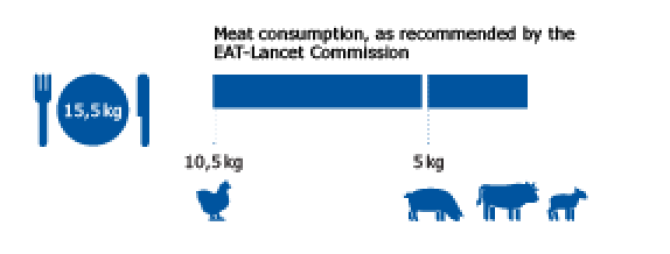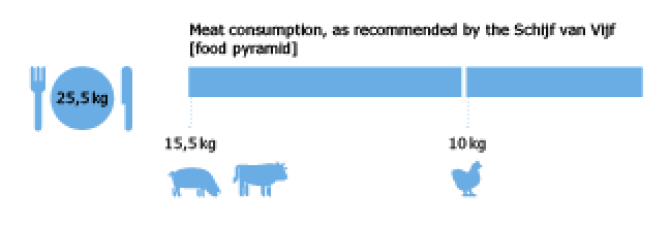
News
We are eating more meat once again
Just like in 2018, the amount of meat and cold cuts consumed in the Netherlands increased in 2019. It is the first time that there was a multi-year increase since the period 2005-2009.
In 2019, the total consumption of meat and cold cuts per capita in the Netherlands (based on carcass weight) was 77.8 kg. This amount is more than 500 g higher than the amount that was consumed in 2018. The increase between 2018 and 2019 is identical to the increase that previously occurred between the years 2017 and 2018. This increase is primarily due to the consumption of poultry meat and, for a small part, also due to the consumption of pork.

Which type of meat do we eat the most?
The amount of meat consumed by each person per year is approximately 39 kg. As a rule of thumb, half of the carcass weight is used when determining the level of consumption. The type of meat we eat the most is pork, of which approximately 18.5 kg per year is eaten. At 11.5 kg per person per year, chicken comes in second. Beef accounts for 8 kg of meat consumption per year. Other types of meat, such as veal, goat's meat, mutton and horse meat are less popular: they collectively account for a little over 1 kg per person per year.
Recommended meat consumption
Dietary recommendations tell a whole different story. They do not correspond with our actual consumption. The Schijf van Vijf [food pyramid] recommends that anyone who wants to eat meat should consume no more than 500 g of meat and cold cuts per week. The amount of red meat (which comes from cows, pigs, goats and sheep) should constitute no more than 300 g of this total amount. This recommended amount of meat and cold cuts amounts to approximately 70 g of meat per day, which amounts to slightly less than 26 kg per year.


While this amount is already considerably lower than the current level of meat consumption in the Netherlands, the authoritative EAT-Lancet Commission's recommendation is even more stringent. Their recommendation involves an additional reduction of 10 kg in comparison to the food pyramid's recommendation. The motto here is approximately 43 g of meat per day. The amount of red meat that is consequently recommended is even more limited than the recommendation in the food pyramid. This means that approximately 5 kg of the annual recommendation of 15.5 kg is left over for beef, pork or lamb.
Hospitality and tourism also count
The amount of meat that is consumed when people eat out and the amount of meat consumed by foreign tourists in the Netherlands have both been included in the figures. Particularly when people eat out they opt for meat. Recent scientific research has confirmed this. For example, Flexitarians, who will regularly enjoy a veggie burger at home, will actually often choose to eat meat when they dine out. This was found in a research study involving 420 German respondents.
A calculation example may help in gaining an idea of the contribution that foreign tourists make to meat consumption in the Netherlands. In 2019, over 51 million foreign tourists stayed overnight in the Netherlands. If we assume that this number of tourists ate around 150 g of meat and cold cuts per day, then their collective contribution to the total amount of meat consumption was 15.5 million kg. Spreading this figure over more than 17 million Dutch people would subsequently yield an amount of approximately 1 kg of meat per person. This would count substantially towards the slight difference between an upward or downward trend in our meat consumption.